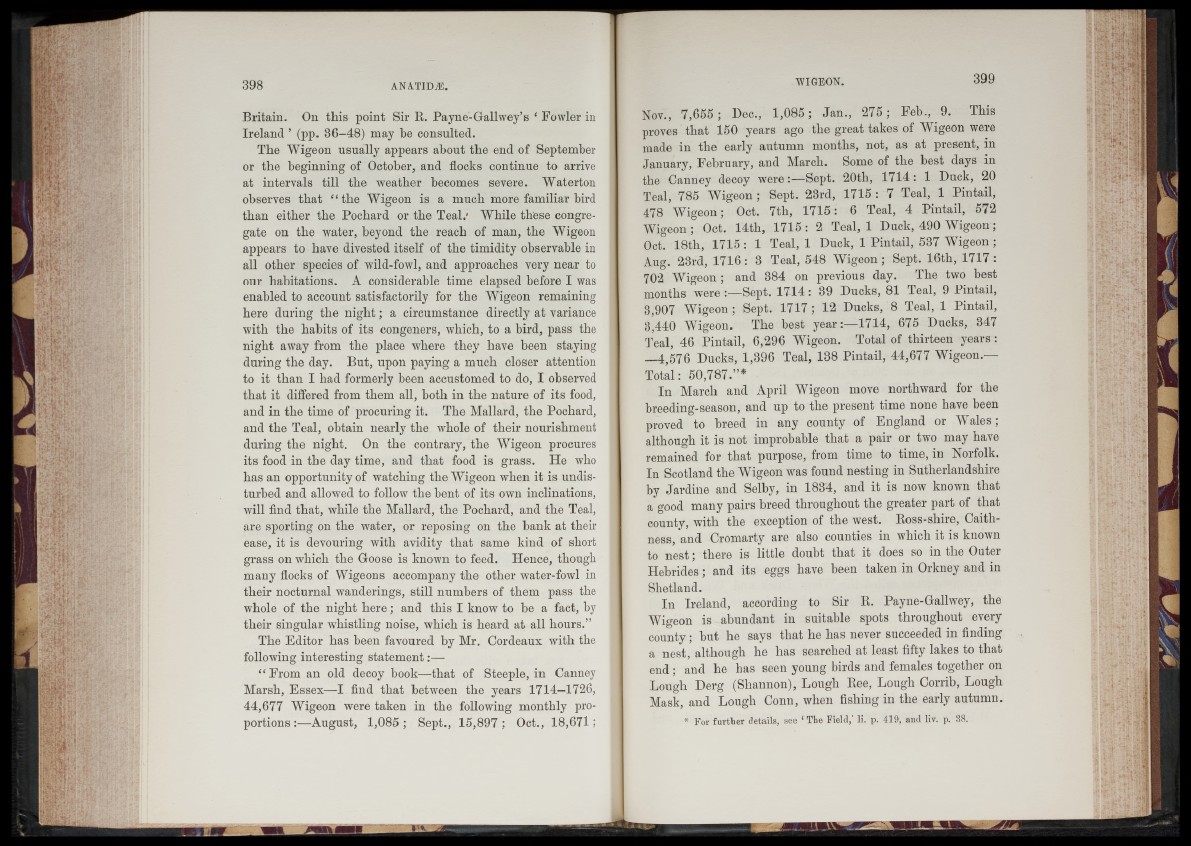
Britain. On this point Sir R. Payne-Gallwey’s * Fowler in
Ireland ’ (pp. 36-48) may be consulted.
The Wigeon usually appears about the end of September
or the beginning of October, and flocks continue to arrive
at intervals till the weather becomes severe. Waterton
observes that “ the Wigeon is a much more familiar bird
than either the Pochard or the Teal.' While these congregate
on the water, beyond the reach of man, the Wigeon
appears to have divested itself of the timidity observable in
all other species of wild-fowl, and approaches very near to
our habitations. A considerable time elapsed before I was
enabled to account satisfactorily for the Wigeon remaining
here during the night; a circumstance directly at variance
with the habits of its congeners, which, to a bird, pass the
night away from the place where they have been staying
during the day. But, upon paying a much closer attention
to it than I had formerly been accustomed to do, I observed
that it differed from them all, both in the nature of its food,
and in the time of procuring it. The Mallard, the Pochard,
and the Teal, obtain nearly the whole of their nourishment
during the night. On the contrary, the Wigeon procures
its food in the day time, and that food is grass. He who
has an opportunity of watching the Wigeon when it is undisturbed
and allowed to follow the bent of its own inclinations,
will find that, while the Mallard, the Pochard, and the Teal,
are sporting on the water, or reposing on the bank at then-
ease, it is devouring with avidity that same kind of short
grass on which the Goose is known to feed. Hence, though
many flocks of Wigeons accompany the other water-fowl in
their nocturnal wanderings, still numbers of them pass the
whole of the night here; and this I know to be a fact, by
their singular whistling noise, which is heard at all hours.”
The Editor has been favoured by Mr. Cordeaux with the
following interesting statement:—
“ From an old decoy book—that of Steeple, in Canney
Marsh, Essex—I find that between the years 1714—1726,
44,677 Wigeon were taken in the following monthly proportions
:—August, 1,085 ; Sept., 15,897 ; Oct., 18,671;
Nov., 7,655; Dec., 1,085; Jan., 275; Feb., 9. This
proves that 150 years ago the great takes of Wigeon were
made in the early autumn months, not, as at present, in
January, February, and March. Some of the best days in
the Canney decoy were:—Sept. 20tlr, 1714 : 1 Duck, 20
Teal, 785 Wigeon ; Sept. 23rd, 1715 : 7 Teal, 1 Pintail,
478 Wigeon; Oct. 7th, 1715: 6 Teal, 4 Pintail, 572
Wigeon ; Oct. 14th, 1715 : 2 Teal, 1 Duck, 490 Wigeon;
Oct. 18th, 1715 : 1 Teal, 1 Duck, 1 Pintail, 537 Wigeon ;
Aug. 23rd, 1716: 3 Teal, 548 Wigeon ; Sept. 16th, 1717 :
702 Wigeon; and 384 on previous day. The two best
months were Sept. 1714 : 39 Ducks, 81 Teal, 9 Pintail,
3,907 Wigeon; Sept. 1717; 12 Ducks, 8 Teal, 1 Pintail,
3,440 Wigeon. The best year:—1714, 675 Ducks, 347
Teal, 46 Pintail, 6,296 Wigeon. Total of thirteen years :
—4,576 Ducks, 1,396 Teal, 138 Pintail, 44,677 Wigeon.—
Total: 50,787.”*
In March and April Wigeon move northward for the
breeding-season, and up to the present time none have been
proved to breed in any county of England or Wales;
although it is not improbable that a pair or two may have
remained for that purpose, from time to time, in Norfolk.
In Scotland the Wigeon was found nesting in Sutherlandshire
by Jardine and Selby, in 1834, and it is now known that
a good many pairs breed throughout the greater part of that
county, with the exception of the west. Ross-shire, Caithness,
and Cromarty are also counties in which it is known
to nest; there is little doubt that it does so in the Outer
Hebrides; and its eggs have been taken in Orkney and in
Shetland.
In Ireland, according to Sir R. Payne-Gallwey, the
Wigeon is abundant in suitable spots throughout every
county; but he says that he has never succeeded in finding
a nest, although he has searched at least fifty lakes to that
end ; and he has seen young birds and females together on
Lough Derg (Shannon), Lough Ree, Lough Corrib, Lough
Mask, and Lough Conn, when fishing in the early autumn.
* For further details, see ‘ The Field,' li. p. 419, and liv. p. 38.